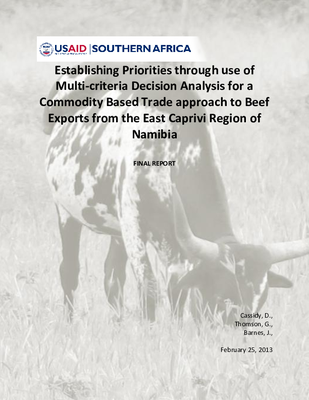Establishing Priorities Through Use of Multi-Criteria Decision Analysis For A Commodity Based Trade Approach To Beef Exports From the East Caprivi Region of Namibia
The Sanitary and Phytosanitary Annex to the Tripartite Agreement between the Southern African Development Community (SADC), the Common Market for Eastern and Southern Africa (COMESA) and the East African Community (EAC) together with the SADC Phakalane Declaration on adoption of non-geographic approaches for management of foot and mouth disease (FMD) take issue with costs associated with current geographic, i.e. zonation-based, approaches to managing animal disease-associated trade risks. Such policies have significant negative repercussions for free-ranging wildlife, largely related to the requirement for veterinary cordon fencing. Given the importance of Africa’s unique wildlife to its tourism sector new approaches to disease risks that both help Africa's pastoralists and farmers and facilitate wildlife-based tourism are needed. The concept of commodity-based trade, is a non-geographic alternative method of preventing the spread of transboundary animal diseases of trade concern. This approach substitutes geographically based measures with product-specific risk management similar to the hazard analysis and critical control points (HACCP) approach universally adopted for food safety management. The SADC Phakalane Declaration recommends that a cross-sectoral economic impact analysis is necessary in locations where livestock and wildlife are both important as contributors to gross domestic product (GDP).
https://biodiversitylinks.org/library/resources/rmp/groups/cbrlm/cbrlm-for-review/decision-analysis-beef-exports-caprivi-namibia/view
https://biodiversitylinks.org/library/resources/rmp/groups/cbrlm/cbrlm-for-review/decision-analysis-beef-exports-caprivi-namibia/@@download/image/image.png
File
Establishing Priorities Through Use of Multi-Criteria Decision Analysis For A Commodity Based Trade Approach To Beef Exports From the East Caprivi Region of Namibia
Author(s):
Cassidy, D.,
Thomson, G.,
Barnes, J.
Publication Date: 2013
Location: Caprivi, Namibia
DOWNLOAD FILE
The Sanitary and Phytosanitary Annex to the Tripartite Agreement between the Southern African Development Community (SADC), the Common Market for Eastern and Southern Africa (COMESA) and the East African Community (EAC) together with the SADC Phakalane Declaration on adoption of non-geographic approaches for management of foot and mouth disease (FMD) take issue with costs associated with current geographic, i.e. zonation-based, approaches to managing animal disease-associated trade risks. Such policies have significant negative repercussions for free-ranging wildlife, largely related to the requirement for veterinary cordon fencing. Given the importance of Africa’s unique wildlife to its tourism sector new approaches to disease risks that both help Africa's pastoralists and farmers and facilitate wildlife-based tourism are needed. The concept of commodity-based trade, is a non-geographic alternative method of preventing the spread of transboundary animal diseases of trade concern. This approach substitutes geographically based measures with product-specific risk management similar to the hazard analysis and critical control points (HACCP) approach universally adopted for food safety management. The SADC Phakalane Declaration recommends that a cross-sectoral economic impact analysis is necessary in locations where livestock and wildlife are both important as contributors to gross domestic product (GDP).



